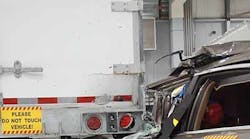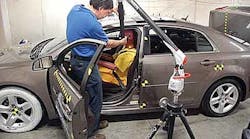Trailer engineers have been issued a new challenge: designing an underride guard that protects even when a crashing car misses almost all of it.
The Insurance Institute for Highway Safety recently released the results of an extensive series crash tests involving eight of the industry’s largest trailer manufacturers. Under controlled conditions at the IIHS test facility in Ruckersville, Virginia, IIHS tested the effectiveness of guard designs by crashing a 2010 Chevrolet Malibu into the back of each of the trailers. IIHS completed the multi-year series of tests in late January and released the test results in March.
Based on measurements generated by instrumented test dummies recorded during the crash, the guards do what they are supposed to do—prevent a car from running underneath a trailer.
On full impact, there is less effect on the test dummy than if the car is driven into a barrier,” says Sean O’Malley, senior test coordinator for IIHS. “If the guard does not allow underride at 35 mph, there is a good chance that the occupants will survive.”
The tests included Great Dane, Hyundai, Manac, Stoughton, Strick, Vanguard, Wabash, and Utility. All of the trailers tested were vans. IIHS selected van trailers built by these manufacturers because they represent the majority of the trailers operating on highways today.
IIHS started the test program in 2010. The Institute began by driving a 2010 Malibu into the center of each manufacturer’s underride guard. In the most recent tests, the guards of each of the manufacturers prevented the car from going underneath the trailer.
The next round involved a 50% offset. This test produced intense loads on the right vertical support member of the guard, along with the crossbar. However, in all but one case these guards also protected the passenger compartment from contacting the rear of the trailer.
The results were reversed in the third round of testing. Only one guard prevented underride in the case of the 30% offset—essentially a test in which the driver is aimed directly at the right rear corner of the trailer. Because of the extreme offset, the car generally misses the vertical support and only contacts the crossbar outboard of the support.
The design that did prevent underride in the extreme offset test was built by Manac. The key, according to Manac’s Charles Dutil, is the spacing of the vertical supports of the guard.
“We place them 18 inches from the edge of the trailer,” he says. “That is 20 inches closer to the edge than our competitors. By placing them where we do, they engage the engine block of the car, even on the 30% and 50% offset tests. When the engine block hits the upright, the guard is strong enough in an offset crash to force the car to rotate and for the rear of the car to kick out. Structurally, our guard probably is not significantly stronger than the others. But by causing the car to rotate, much of the force of the impact is dissipated.”
Manac, the sole Canadian trailer manufacturer included in the battery of crash tests, did not redesign its underride guard to comply with Canadian underride standards which generally are considered more demanding than their U S counterparts.
“Our old design fully complied with Canadian requirements,” Dutil says. “But even though our previous design complied, the crash damaged the floor and slider tracks more than we thought it should. We looked for ways to simplify our design in such a way that we limit the damage to the lower section of the structure.”
Manac conducts its own underride tests. The company evaluates underride guards by mounting them on a trailer, applying force as required, and measuring the results.
An array of options
Moving the vertical supports closer to the edges of the trailer is one way to enhance the performance of underride guards in extreme offset crashes, but other options are possible, such as stronger crossbars or support for the crossbar at the edge of the trailer. All involve trade-offs.
Even spreading the vertical supports apart is a trade-off,” one underride expert says. “Wide spacing helps prevent underride in the event of an offset crash, but it adversely affects the performance when the car hits the center of the guard. This is a complex issue. The overriding issue for all of us is to save lives. That means looking at every angle. The trailer, the car, and how the two vehicles interact with one another. And of course, there is the role of the driver. What causes someone to drive into the back of a trailer? The reasons are many.”
So what is an engineer to do?
“The guards are performing as they should except in the severe offset test,” O’Malley says. “We do think that underride guards can be attached to trailers better and could be made stronger. We don’t design trailers or cars, so exactly how that can best be accomplished we leave to the experts.
“We also think that the regulations could be improved. We are recommending that NHTSA consider requiring a uniform strength across the width of the guard. It makes little sense to pick and choose where the guard needs to be strong.”
Searching for answers
The seeds of the research project date back to 2009 as part of a larger question: “How do people continue to die in crashes that otherwise are survivable?” One of the areas that drew the attention of researchers was underride.
“We asked ourselves, ‘What can we do to reduce this?’” says Matthew Brumbelow, senior research engineer.
Accident statistics provide almost as many questions as answers. Solid information on what is happening on America’s highways is sketchy at best. Police reports that form the basis of highway fatalities do not provide the level of detail required to evaluate underride performance. The Institute estimates that 300 people die annually from crashing into the rear of trailers, but it remains difficult to determine how many of those deaths can be attributed specifically to underride—or to know how real world accidents correlate to the underride strength requirements spelled out in FMVSS 223 and 224.
IIHS believes that lives can be saved with revised underride guards and has petitioned NHTSA for tougher performance standards. The Institute also asked the agency to expand the regulations to cover other types of large trucks, such as dump trucks.
New rules coming?
To date, NHTSA has not responded to the IIHS request. However, the agency recently contracted with Waltonen Engineering, an engineering and design services company based in Warren, Michigan, to generate the type of data that can be used to support future rulemaking.
Waltonen is analyzing underride guards both past and present, including those built in 1998 and 1999 immediately after the implementation of FMVSS 223 and 224. The company also is evaluating guards that were installed after Canada implemented its own underride regulations, generally considered to be more demanding than those of the United States, in 2007. As standard practice, major trailer manufacturers now voluntarily equip their trailers with underride guards that comply with those higher standards.
As part of its contract with NHTSA, Waltonen will analyze the components that trailer manufacturers use to build their guards. The purpose of this is to estimate not only the effectiveness but also the production costs of various design options.
According to Mark Miller, program manager and business developer at Waltonen, the research is expected to be complete and delivered to NHTSA in August.
__________________
Click here to view all large photos and captions
for Underride crash test










